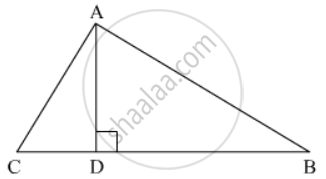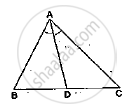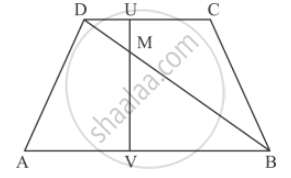Advertisements
Advertisements
Question
In a ∆ABC, perpendicular AD from A and BC meets BC at D. If BD = 8 cm, DC = 2 cm and AD = 4 cm, then
Options
∆ABC is isosceles
∆ABC is equilateral
AC = 2AB
∆ABC is right-angled at A
Solution
Given: In ΔABC,`AD ⊥ BC`, BD = 8cm, DC = 2 cm and AD = 4cm.

In ΔADC,
`AC^2=AD^2+DC^2`
`AC^2=4^2+2^2`
`AC^2=20`..............(1)
Similarly, in ΔADB
`AB^2=AD^2+BD^2`
`AB^2=4^2+8^2`
`AB^2=80`......................(2)
Now, In ΔABC
and
Hence, triangle ABC is right angled at A.
We got the result as (d)
APPEARS IN
RELATED QUESTIONS
In below Figure, ΔABC is right angled at C and DE ⊥ AB. Prove that ΔABC ~ ΔADE and Hence find the lengths of AE and DE.

In a ΔABC, AD is the bisector of ∠A.
If AB = 5.6cm, BD = 3.2cm and BC = 6cm, find AC.

In the given figure,

AB || DC prove that
(i) ∆DMU ∼ ∆BMV
In ∆ABC, ∠A = 60°. Prove that BC2 = AB2 + AC2 − AB . AC.
In ∆ABC, ∠C is an obtuse angle. AD ⊥ BC and AB2 = AC2 + 3 BC2. Prove that BC = CD.
ABCD is a rectangle. Points M and N are on BD such that AM ⊥ BD and CN ⊥ BD. Prove that BM2 + BN2 = DM2 + DN2.
The areas of two similar triangles are 169 cm2 and 121 cm2 respectively. If the longest side of the larger triangle is 26 cm, what is the length of the longest side of the smaller triangle?
The lengths of the diagonals of a rhombus are 30 cm and 40 cm. Find the side of the rhombus.
∆ABC and ∆BDE are two equilateral triangles such that D is the mid-point of BC. The ratio of the areas of triangle ABC and BDE is
In a ∆ABC, ∠A = 90°, AB = 5 cm and AC = 12 cm. If AD ⊥ BC, then AD =
